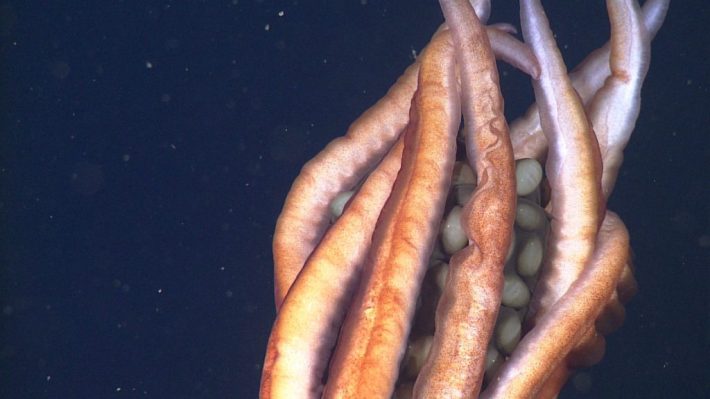Some would say there is no sweeter image than that of a new mother cradling her cooing infant child. Today, I'd like to share with you an even sweeter picture: a new mother cradling 30 to 40 of her children, who are still eggs, in her hooked and sucker-covered arms. To make it even more beautiful, it's a video, and not even a vertical, front-facing one!
The squid mom below was filmed in 2015 by researchers from the Monterey Bay Aquarium Research Institute piloting the remotely operated vehicle Doc Ricketts, which was named for a famously hot scientist who had 15 animal species and a nightclub named after him. The researchers dropped the ROV in the Gulf of California to discover how many creatures dwell in the deep regions of the ocean with extremely low levels of oxygen. A little past 8,400 feet below the surface, a large red squid hovered into view, carrying several dozen eggs in her fleshy arms.
Most squids have a much more carefree approach to childcare, which is to say they lay their eggs and immediately die. As such, it's often difficult for scientists to track where these eggs go, beyond the mouths of hungry predators. Some squids anchor their eggs to the seafloor. Some jumbo squids lay diaphanous masses holding up to 90,000 eggs that hover, neutrally buoyant, in the open water. But deep-sea squids have a strategy all their own. Some brood their eggs, carrying their eggs in large sheets resembling Hong Kong egg waffles as they drift in the dark.
MBARI scientists have observed a few other species of deep-sea squid brooding their eggs over 37 years of exploration. They've observed several black-eyed squid Gonatus onyx holding a rippling balloon of tiny eggs, which the squid carry using the hooks on its arm. And they've filmed squids in the genus Bathyteuthis grasping hundreds of tiny translucent eggs in a curtain-like sheet. These brooding squids cannot eat while brooding, so they sustain themselves on energy reserves until their eggs hatch and they are free to die.
The newly filmed squid appears to be a new species in the family Gonatidae, or the armhook squids. They are named for the many hooks on their arms, which are actually modified suckers, and larger hooks on their two long tentacles. The researchers were struck by how large the new squid's eggs were—each nearly half an inch in diameter, twice as large as prior observations of brooding Gonatus squids and the largest recorded of any squid. And while other Gonatus squids would carry sheets of up to 3,000 eggs, this mother had just 30 to 40.
Laying thousands of eggs might be a good bet for shallow-water squids living in unpredictable environments with variable amounts of food and predators. But the researchers suggest a strategy of investing more time and care into fewer eggs might pay off in the relatively stable environment of the deep sea. "Her sacrifice improves the chances that her offspring will survive. It’s just one of the many remarkable adaptations that may help cephalopods to survive in the deep sea,” Henk-Jan Hoving, a researcher who leads the deep-sea biology working group at GEOMAR in Kiel, Germany, and conducted this research while at MBARI, said in a statement. The deep-sea octopus Graneledone boreopacifica relies on this strategy to an extreme degree, brooding its eggs for over four years.

But larger eggs take longer to develop, and the researchers predict this squid's eggs require at least 1.4 years to develop into squidlets. This timeline is remarkable, not just for the effort it requires from mother squids but also for the fact that this exceeds the lifespan of most cephalopods living in shallow or coastal waters. The researchers suggest that squids can only perform such a vulnerable act of brooding in these oxygen-low regions of the ocean, where predators may be sparser. Either way, it's a long time to be drifting in the deep while doing your best to avoid being eaten.
As this mother squid was filmed in 2015, her eggs would have hatched long ago, leaving her to die and sink to the bottom of the Gulf of California. Somewhere in the gulf, a deep basin called the Cerralvo Trough has become an unofficial squid graveyard, where the carcasses of mother squids and the remnants of their egg sheets settle in the murk to feed these even deeper creatures. In 2012, MBARI researchers recorded a fall of dead squid and egg sheets that had become a banquet for ratfish, acorn worms, brittle stars, sea cucumbers, crustaceans, and sea stars. It seems the mothers all died simultaneously, releasing their babies into the deep as they sunk together until ratfish ripped off their tentacles for a snack. And isn't that a beautiful image, too!






